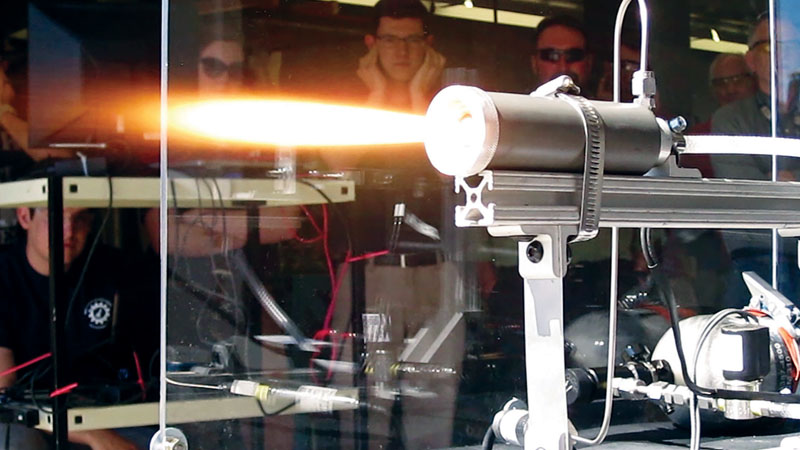Stay Up to Date
Submit your email address to receive the latest industry and Aerospace America news.
The Hybrid Rockets Technical Committee studies techniques applied to the design and testing of rocket motors using hybrid rocket systems.
The year witnessed the maturation of several hybrid rocket technologies into their advanced test stages in both industry and academia. It started loudly with the launch of the Taiwanese APPL-9C on Jan. 31 near Hsinchu City, Taiwan. The Advanced Rocket Research Center based in National Chiao Tung University developed this two-stage system, which featured a first-stage sugar rocket with a hybrid second stage that made use of nitrous oxide in a 3-D printed shell. The launch of the 27-kilogram-loaded, 2.7-meter-long rocket with a 15-centimeter diameter has paved the way for future tests of the larger HTTP-3 hybrid vehicle.
The NASA-funded Jet Propulsion Laboratory in California is developing a space-storable hybrid motor for a Mars Ascent Vehicle, or MAV, as part of the proposed Mars Sample Return mission. A comprehensive JPL-led trade study found a storable, single-stage-to-orbit, hybrid propulsion system to be the lowest mass option for a MAV.
At NASA’s Marshall Space Flight Center in Alabama this year, a new, wax-based fuel developed by the Space Propulsion Group of California survived more than 200 Mars-like thermal cycles, emulating mission-like thermal profiles over a range of 50 to minus 115 Celsius (122 to minus 175 Fahrenheit). JPL is also funding hotfire testing of this fuel with nitrogen tetroxide. That testing is underway at SPG and California-based Parabilis Space Technologies. In the interim, researchers at Purdue and Penn State universities are investigating new solid additives to the fuel for hypergolic ignition to enable multiple starts of the hybrid motor as part of this program. JPL is in the planning stage for an Earth-based launch of a hybrid MAV, scheduled for 2019. Along similar lines, JPL is testing high-density polyethylene and polymethyl methacrylate with gaseous oxygen for cubesat applications. The goal of this three-year program is to demonstrate long-duration burns and multiple, autonomous ignitions to enable interplanetary cubesat mission concepts. Tests of up to 50 seconds were completed in 2016. Utah State University received a $200,000 NASA grant to develop and test small rocket motors that could be used in lieu of hydrazine thrusters in small satellite applications. The motors are made of printed acrylonitrile butadiene styrene plastics with a meshwork of finely spaced voids. A voltage through the electrodes causes electrical charges to accumulate in the voids to the extent of building an arc in the core. Oxygen is then introduced to initiate burning. Testing is expected to begin in mid-2018 as the thruster payload is delivered to an altitude of 100 kilometers on board a NASA sounding rocket.
In May, Nammo AS, a company based in Raufoss, Norway, hotfired its Flight-Weight Unitary Motor intended for the Nucleus sounding rocket. Using hydrogen peroxide and hydroxyl-terminated polybutadiene, the test included two burns spaced by two hours and 35 minutes to demonstrate the engine’s restart capabilities. Both burns produced stable combustion and 30 kilonewtons of thrust. This 800-kg, 9-m-long flight vehicle is the first member of the Norwegian North Star sounding rocket family. Nucleus will be launched in the first half of 2017 with a target altitude of 100 km and a payload of 70 kg.
In July, Gilmour Space Technologies, based in Singapore and Australia, launched its first test rocket as a first step toward its stated goal of reducing the cost of orbital and suborbital launches. The Rasta rocket, powered by nitrous oxide and dual 3-D printed fuel, achieved an altitude of 5 km.
Announced Aug. 1, the FAA granted Virgin Galactic an operator license to test SpaceShipTwo, a suborbital spaceplane, for two years over the Mojave Air and Space Port in California. The license allows the transport of scientific and experimental payloads but prohibits “spaceflight participants” until the reliabilities of SpaceShipTwo and WhiteKnightTwo, its carrier vehicle, have been carefully verified. ★
Stay Up to Date
Submit your email address to receive the latest industry and Aerospace America news.




